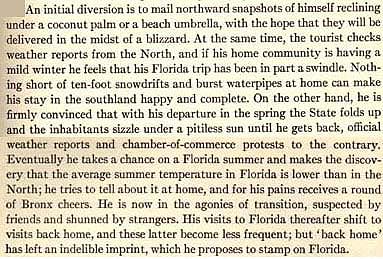
Having introduced
the tourist as a part of the long heritage of invaders of Florida, and
having expanded the way that we understand who may be a tourist, the narrative
turns to the tale of how the tourist eventually "becomes by slow degrees
a citizen and a critic. The evolution of a tourist into a permanent resident
consists of a struggle to harmonize misconceptions and preconceptions
of Florida with reality" (7). The authors dramatize the process with colorful
descriptions of the tourist encountering various "authentic" Florida adventures;
a Spanish dinner in the Latin quarter of Tampa, following the Tamiami
Trail through the Everglades, visiting the artistic community at Key West,
tromping through the muck lands around Lake Okeechobee, taking a glass-bottomed
boat ride at Ocala, etc. On the tourist's second visit,
 |
|
Click
on image to see passage in its context...look for the red arrow
|
This
account of what it takes to convince a tourist to become a permanent resident,
though written with great style, lacks a bit in the reality department.
Evidentally the process of harmonizing "misconceptions and preconceptions
of Florida with reality" is a matter of realizing that the summers are
better in Florida, too. Here we have to give credit to the fact that aside
from being (in some ways) a piece of Florida tourism propaganda, the guidebook
is also writing in the local color style, which means it necessarily treats
cultural issues with humor and sweeping gestures.
 |
|
|
|
4
|
|
 |
•
Juliet Gorman, May 2001 •
|
|

|